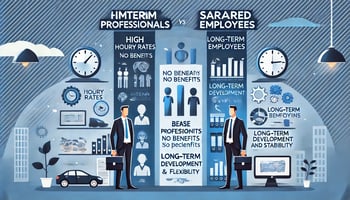The Cost Dynamics of Hiring: Interim Professionals vs. Payroll Employees In today's dynamic...
How Interim Leaders Can Drive Success During Business Transitions
 Business is dynamic. Companies are constantly evolving, whether due to growth, restructuring, market changes, or new technology. But sometimes, transitions don't go as smoothly as planned. Teams get stuck, priorities become unclear, and momentum stalls. In these moments, businesses need strong, experienced leadership to steer the ship—but often, they lack the right person to take control.
Business is dynamic. Companies are constantly evolving, whether due to growth, restructuring, market changes, or new technology. But sometimes, transitions don't go as smoothly as planned. Teams get stuck, priorities become unclear, and momentum stalls. In these moments, businesses need strong, experienced leadership to steer the ship—but often, they lack the right person to take control.
This is where interim leaders come in.
Why Do Companies Get Stuck in Transition?
Periods of change create uncertainty. Business leaders might face several challenges, including:
- Leadership Gaps: When a key executive leaves unexpectedly, critical decisions get delayed.
- Changing Market Conditions: New competitors, regulations, or economic shifts can derail even the most solid strategy.
- Internal Resistance: Employees may resist change, slowing transformation projects or cultural shifts.
- Scaling Issues: Growth can be both exciting and overwhelming, leading to disorganization and inefficiency.
These factors can cause businesses to lose focus, burn out their teams, and waste valuable time. This is where an interim executive becomes an asset—not just a stopgap, but a catalyst for progress.
What Is an Interim Leader?
An interim leader is a highly skilled professional hired temporarily to fill key leadership roles during periods of transition. These leaders are experts in navigating complex business challenges, bringing a wealth of experience to quickly assess the situation, set priorities, and execute strategies.
Interim roles can include:
- Interim CEOs: Leading company-wide transformation or recovery efforts.
- Interim CFOs: Stabilizing financial operations, restructuring debt, or managing mergers and acquisitions.
- Interim COOs: Reorganizing processes, improving efficiency, and implementing scalable operations.
- Interim CIOs/CTOs: Driving digital transformation and innovation efforts.
Unlike permanent hires, interim leaders can hit the ground running, without the lengthy hiring process or onboarding time.
How Interim Leaders Drive Change and Results
-
Fresh Perspective:
Interim leaders are not tied to internal politics or legacy practices. They bring an objective viewpoint, helping identify blind spots and inefficiencies. -
Immediate Expertise:
Companies in transition often can’t afford to spend months training someone to understand their challenges. Interim leaders have "been there, done that." They provide hands-on expertise and implement best practices tailored to your unique needs. -
Stabilization and Strategy:
In times of uncertainty, employees look for steady leadership. Interim executives provide stability, communicate a clear vision, and build trust across teams. They create roadmaps to guide businesses out of stagnation and onto a path of growth. -
Change Management:
Change is often met with resistance. Experienced interim leaders know how to manage stakeholders, overcome resistance, and align teams around new strategies or systems. -
Results-Driven:
Interim leaders are focused on delivering results. Their goal is to execute key initiatives and leave the business stronger than when they arrived. This results-oriented mindset ensures they deliver measurable outcomes within tight timelines.
When Should You Consider Hiring an Interim Leader?
You should consider interim leadership if your company is facing:
- A leadership vacancy that can’t be filled quickly.
- Critical transformation projects (e.g., digital transformation, mergers, or restructuring).
- Organizational crises (e.g., declining revenue, operational inefficiencies).
- Rapid growth or scaling challenges that require experienced leadership.
- Post-merger integration where aligning different cultures and operations is key to success.
In these scenarios, interim leaders can accelerate progress and prevent prolonged disruption.
Real-World Success Stories
At one of our recent clients, an interim Chief Financial Officer (CFO) was brought in to stabilize a company facing cash flow challenges. Within six months, the CFO restructured debt, optimized the cost structure, and put in place a robust financial planning system. The company not only recovered but achieved a 20% year-over-year profit increase.
Another example: A business undergoing a digital transformation needed an interim Chief Information Officer (CIO) to lead the charge. Within a year, the interim CIO modernized their IT infrastructure, introduced automation, and streamlined business processes, saving the company millions.
These results are not anomalies—they are what experienced interim leaders are trained to deliver.
Interim Leadership: A Strategic Advantage
While some companies hesitate to bring in interim executives because of perceived short-term costs, the reality is that failing to address leadership gaps can be far more expensive. Delays, lost productivity, and poor execution can cost companies millions in missed opportunities.
Interim leaders provide both immediate stability and long-term value by delivering results faster and more effectively than many permanent hires. They are a strategic tool for businesses looking to stay agile and competitive in a rapidly changing world.
Ready to Unstick Your Business?
If your company is stuck in transition or facing complex challenges, we can help. Our network of seasoned interim leaders specializes in driving growth, transformation, and recovery for businesses of all sizes. Reach out to us today to learn how we can help your organization move forward.
What’s your experience with interim leadership? Have you worked with interim managers in the past? Share your thoughts and stories in the comments below!
#Leadership #ChangeManagement #InterimLeadership #BusinessGrowth #Transformation #Consulting



